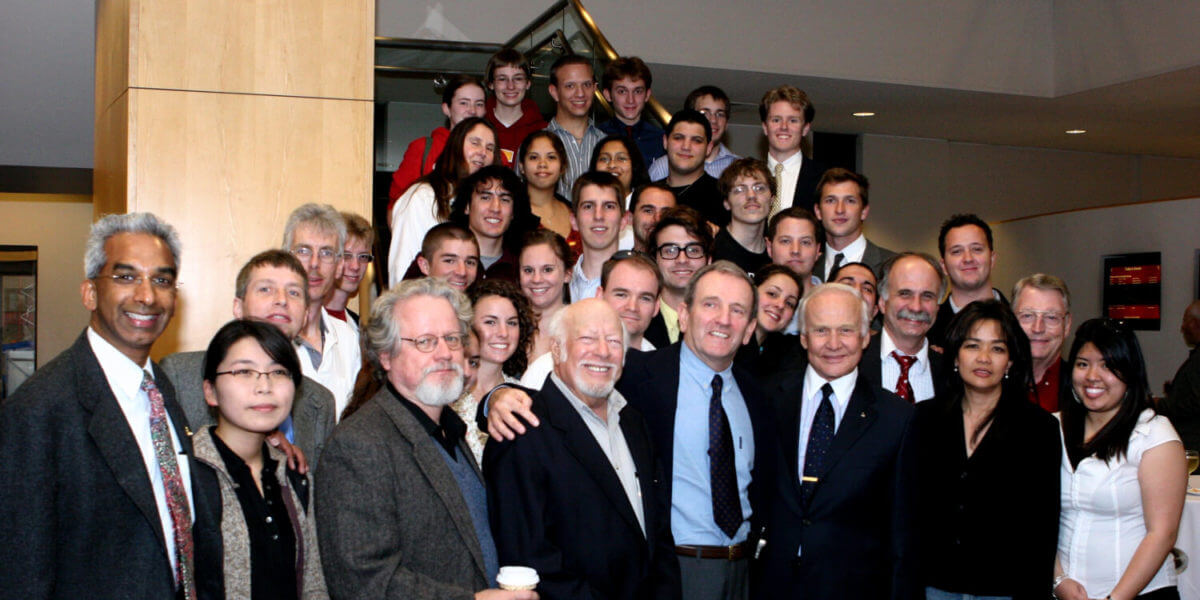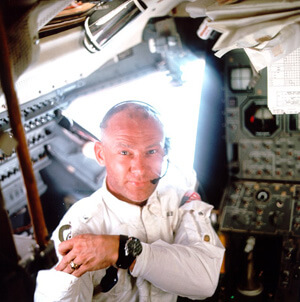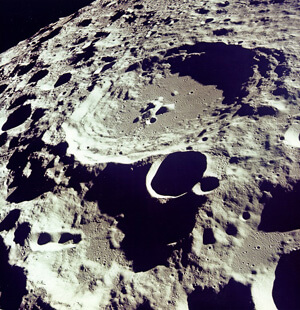From the Moon to Mars
Diane Ainsworth | April 03, 2006
Apollo 11 astronaut Buzz Aldrin presents Viterbi School centennial lecture on the future of space exploration

Aldrin with USC astronautics faculty and students in Davidson Conference Center. Photo by Brian Morri.
He left his boot prints and an American flag on the moon 36 years ago, but he brought back new insights into space travel to the moon and beyond. On March 29, 2006, legendary Apollo 11 astronaut Edwin E. “Buzz” Aldrin Jr. shared those insights with USC students and faculty in the USC Viterbi School's Astronautics and Space Technology Division lecture to celebrate 100 years of engineering at USC.

Buzz Aldrin addresses astronautics students and staff at a Viterbi School centennial lecture entitled "To the Moon and Beyond." Photo by Brian Morri.
In a lecture entitled, “To the Moon and Beyond,” Aldrin, the second human being to walk on the moon, laid out a long-term plan to return Americans to the moon and make space travel to Mars routine.
“Apollo 11 symbolized the success of our program to send humans to the moon,” he said, “but to reignite public support for space, this country needs to make a long-term commitment to establishing a permanent presence in space…and we need the will to do it.”
A familiar face to engineering and architecture graduate students, Aldrin has been visiting the campus on final exam day for two years now to critique ASTE 527 (Space Exploration Architectures Concepts Synthesis Studio) class projects. Each fall semester, the students are challenged to present designs for moon and Mars transportation systems, habitats, roving vehicles, spacesuits, and communications systems. The course is taught by Madhu Thangavelu, a studio conductor and longtime aerospace industry consultant, and it’s always full.
Aldrin’s dedication to space exploration hasn’t wavered in the years since Apollo. Nor has his worldwide reputation as one of only 12 human beings ever to have walked on the moon. That moon-walking fame has kept him in the forefront of many debates over the Moon-to-Mars initiative. He’s written books and technical papers on the subject, and given thousands of talks all over the world. In fact, it’s hard to keep up with his activities.
Today he oversees a rocket design company, Starcraft Enterprises in Laguna Beach, CA, holds a patent for a space station design, sits on the boards of many space R&D companies, and runs a nonprofit space foundation, the ShareSpace Foundation, which is devoted to space tourism.
Space Tourism

Aldrin salutes the American flag that he's just set up on the moon on July 20, 1969.
He called space tourism “essential to getting people behind our programs of exploration,” but said the Russians are making more headway than the U.S. with the “Clipper” spacecraft.
“I’m afraid that if we don’t finance it, somebody else will, and while we’re sending capsules and landers to the moon, they’ll be taking over tourism in low-Earth orbit and going to our space station,” he said.
Part of the problem lies in the country’s short-sighted goals for space.
“We’re focusing too much on short-term interests that suit contractors rather than visions of evolving a human spaceflight capability beyond low-Earth orbit,” he said. Among many alternatives, Aldrin’s company has investigated some new reusable launch vehicle designs that would bring down costs and increase the reliability of rockets. Starcraft Enterprises has also developed blueprints for crew vehicles that are based on designs derived from a Russian BOR-4 mini-shuttle.
“Nobody’s going to build a 60-person spacecraft,” he said. “NASA doesn’t need it and the private sector can’t afford it, but we have six-person spacecraft, so the only answer is to put five or six spacecraft on a big rocket, at least that’s my guess right now. We can’t have a program of tourism just for the wealthy.”
While space tourism begins to take hold, Aldrin believes the country should initiate a Moon-to-Mars program and start sending astronauts back to the moon. But unlike the Apollo program, the moon should be treated as a jumping-off point only, rather than a final destination. From the moon, payloads and people could go on to Mars.
Aldrin Cyclers
Aldrin devised a transportation system of “cyclers” back in the mid-1980s to continuously shuttle cargo and passengers between Earth and Mars. More recently, he joined forces with universities such as Purdue, MIT and the University of Texas to design these vehicles.

In lunar orbit aboard Apollo 11.
Cyclers would take advantage of gravity assists to gain momentum and make periodic flybys of Earth and Mars. “Taxi” vehicles carrying cargo and passengers could rendezvous with these orbiting spacecraft for trips to both planets. Aldrin believes that NASA’s next generation space shuttle, the new Crew Exploration Vehicle, could be used as a taxi for the cyclers.
Aldrin’s interest in space transportation systems goes back to his graduate student days at MIT. He grew up around aviation, with a father who studied rocketry under Robert Goddard. After earning a bachelor’s degree with honors in 1951 from the U.S. Military Academy at West Point, New York, he entered the U.S. Air Force and earned his pilot’s wings. Between 1950 and 1953, he flew 66 F-86 combat missions in the Korean War and shot down two MiG 15s. Later he entered MIT to study “piloted rendezvous” — bringing two spacecraft into close proximity with each other — and wrote his thesis on “Guidance for Manned Orbital Rendezvous.”
In 1963, NASA selected him for the third group of astronauts. He was the first astronaut to have a Ph.D., so he quickly earned the nickname Dr. Rendezvous. But during his Gemini 12 flight in November 1966, Aldrin’s rendezvous abilities were put to the test: an onboard radar failed, forcing him to manually recompute all of Gemini’s rendezvous maneuvers.
Lunar Orbit Rendezvous
Aldrin’s expertise helped his Apollo training as well. He praised a behind-the-scenes engineer at Langley Research Center in Hampton, VA, for coming up with the idea of a “lunar orbit rendezvous” (LOR) for the Apollo flights. Later, he got involved in the first test flights in which two astronauts in a Lunar Module separated from the third astronaut in the Lunar Command and Service Modules. The engineer’s name was John Houbolt and his LOR strategy made the Apollo 11 moon walk possible.

Daedalus Crater, seen from the window of Apollo 11.
During the lecture, Aldrin recounted some of the humorous moments of Apollo 11, such as the difficulty he had stretching out the American flag and standing it upright in the ground. Although the top inch or so of lunar soil was soft, subsurface layers were hard and compressed, making it difficult to hammer the flagpole more than five or six inches into the ground.
“Absolutely, there’s no doubt about it, Apollo 11 had the best looking flag on the moon, until we lifted off and it blew over,” Aldrin said.
The lecture was sponsored by three USC offices, including USC Spectrum, the USC Office of the Provost, and the Viterbi School of Engineering’s Office of Admission and Student Affairs. Michael Gruntman, chairman of the Astronautics and Space Technology Division, introduced Aldrin, who appeared before a full house of students in USC’s Town & Gown conference center. The talk was followed by a reception in Davidson Conference Center.
Students spent an hour with Aldrin, asking about the space shuttle program, his experiences on the moon, how to become an astronaut, and how to build better space vehicles. Astronautics undergraduates pressed him for details about commercial space flight companies and the recent success of Spaceship One, a one-person rocket launched into low-Earth orbit for a fraction of the cost NASA spends launching space shuttles. One student asked Aldrin to autograph a thick piece of black glass that he planned to take in space with him some day.
“This event will undoubtedly be with the students for a long time,” Gruntman said. “That’s what faculty wanted to happen when they organized the event. We wanted to give students the opportunity to talk with Aldrin.”

